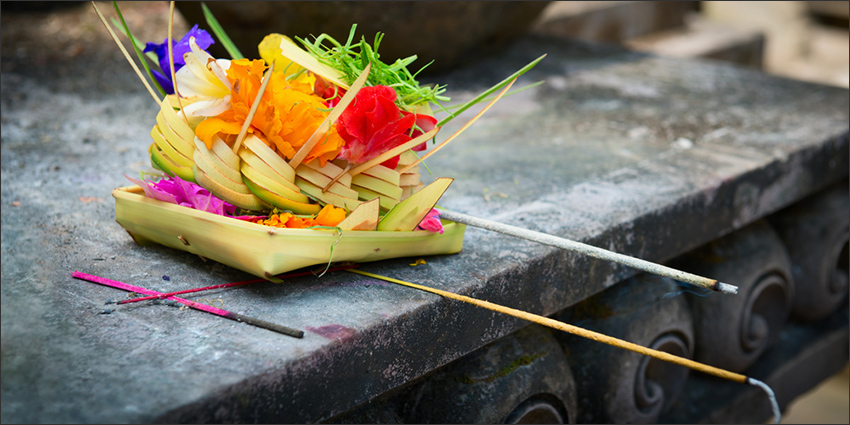Some people burn incense in their home, believing it purifies the space or at least masks unpleasant smells. However, here are some facts about incense that you may not know…
Burning incense is not a space clearing technique
In my book, Creating Sacred Space with Feng Shui, I explained that incense is used in most of the major religions of the world because it is a quick, easy way of raising the vibrational level of the atmosphere of a place. Many Asian cultures also use it because they believe that the upward movement of the smoke helps to waft the essence of their offerings and prayers up to the gods.
However, it is not actually a space clearing technique because as soon as the aroma dissipates, the effect is lost. Burning incense in a space does not permanently change anything energetically.
The reason I included the use of stick or resin incense in the space clearing ceremony I described in my book was because I wanted to offer as much help as possible to people doing space clearing for the first time. By temporarily raising the atmosphere, it helps to get a better result, especially if there is a lot of clutter in the home.
However, I no longer use incense, the professionals I train no longer use it, and it will not be part of the updated description of the ceremony in the new space clearing books Richard and I are writing. There have been so many new developments over the last 20 years in the techniques we teach that it is no longer needed.
Many types of incense are a health hazard
To the best of my knowledge, the two types of incense I recommended in my book were made of high-quality natural ingredients that were fine to use for doing space clearing in a ventilated space. But those particular brands are difficult to find now and using substitutes can be fraught with problems.
Commercial incense sticks generally consist of a bamboo stick coated in herbal, wood and adhesive powders, with some type of fragrance added, often synthetic. Cheaper varieties can contain anything from melted down rubber tyres, inner tubes and engine oil, to albumen powder made from the dried blood of slaughtered animals. It really is anybody’s guess what they’re made of because the ingredients are rarely listed on the packaging.
This is not a problem in places such as Bali, where the temples are all open air, or in western countries, where most people only burn incense very occasionally. But it’s causing serious problems in indoor temples in places like Thailand and Taiwan, where multiple joss sticks are burned at the same time. Each stick emits roughly the same level of toxins as a cigarette, so being in a temple with several hundred joss stick burning simultaneously exposes everyone there to the same level of health hazard as being in a room with several hundred smokers puffing away.
One study found that commonly used incense sticks emit carbon monoxide, sulphur dioxide, nitrogen dioxide, aldehydes, ketones, xylenes, diethylphthalate and polycyclic aromatic hydrocarbons, including formaldehyde.
Another study conducted over a two year period in Thailand by Dr Manoon Leechawengwong analyzed the blood and urine samples of temple workers and showed they had a very much higher risk of certain types of cancers. Benzene levels (implicated in leukaemia) were found to be four times higher than normal. Butadiene levels (related to blood cancer) were an astonishing 260 times higher. And levels of benzo(a)pyrne, which is known to cause lung, bladder and skins cancers, were 63 times higher. Other studies have raised similar concerns.
Temple workers in Thailand’s 37,000 Buddhist temples are now encouraged to wash their hands after handling incense and have annual health checks. People visiting temples are advised to use shorter joss sticks instead of the full-length ones that used to be popular, to burn them only while prayers are in progress and then extinguish them, and to avoid using them at all in poorly ventilated areas.
It’s rather ironic that what is widely believed to be a purification technique has actually been found to be so toxic to those who use it in their devotional prayers. Perhaps incense used to be purer in the days when it was all made by hand and the move to mass-production is the reason why that’s changed. But whatever the case, I no longer know of a single reason ever to use it.
Copyright © Clear Space Living Ltd 2017, updated 2021
Related article
Why smudging is not a space clearing technique
Like to read more articles like this?
Subscribe to my newsletters to receive news, articles and information about upcoming online courses by email. And I promise you – no junk mail ever.





Thank you for the heads up about incense.
We found it made asthma and headaches worse, and quickly overpowered a room if a window is not open. The cheap imported incense smells terrible when burned. I guess now I know why.
I keep a bouquet of very pure incense sticks in a vase without burning them. The essential oils gently mix with the air as I walk past giving a subtle waft of fragrance, which lasts longer and smells better unburned. But they do gather dust and wear out after a while.
So maybe switching to an oil warmer with beeswax candles would be better?
This makes a lot of sense to me. I have only used sage smudge sticks and frankincense resin that I know are made ethically, as well as juniper sticks from Juniper Ridge, a company dedicated to harvesting ethically and sustainably, and who contribute to wilderness protection. However, I have wondered about how long the effects of incense last so your article is timely.
I live in a senior apartment complex which bans cigarette smoking yet oddly allows residents to burn incense. My issue is I live upstairs and it wafts into my tiny apt. from someone burning it 24/7. No one will admit to it. Yet it enters the window where I sit at my desk and burns my eyes and smells bloody awful. I will print this article to send to the apartment manager who is reluctant to do anything about it since those who use it claim it is for their mental, psychological or spiritual (I am being redundant here sorry) well being. Meanwhile, *my* mental physical and emotional well-being suffers daily from this intrusion that the manager is afraid to deal with. Thank you for the informative article!
I am currently at the last chapter of your book for space clearing. Is it possible to leave out the incense in the offering but following all the rest of the steps? As i have sinus issues and very sensitive to smells…..incense usually leaves me with a blocked nose for days…..
Furthermore it is hard to get quality incense here.
I explain in this article that there is no need to use incense when space clearing. I no longer use it, the professionals I train no longer use it, and it will not be part of the updated description of the ceremony in the new space clearing book I am writing.
Hi Karen. I just recently found your website and find it really informative. Two things: first, I have read that offgassing actually gets worse with time, and is never completely finished. And second is a question: what about resin like copal and frankincense? I’m assuming there should be no chemicals in resin? Thank you!
Hi Dana – Offgassing improves with time. This study published in the International Journal of Ventilation explains that there is ‘a rapid decline in emissions during the first month or so, followed by a more gradual decline (with fluctuations due to seasonal changes in temperature, humidity, etc.) until approximate steady state is reached after at least two years.’ Other studies have concluded that outgassing continues for longer but always reduces with the passage of time. It could only get worse with time in a building that is completely sealed, such as one that has windows that are designed never to be opened.
To my knowledge, incenses made of natural, untreated resins such as frankincense, are not toxic, but when used indoors it is still advisable to have a window open.
Hi Karen,
Thanks for the info in this article.
Wondering, what is now used in the flower offerings for the spirits of the air?
Thank you.
Hi Simon – It sounds like you are asking about the short description of flower offerings included in Creating Sacred Space with Feng Shui, which is now out of print because it is so out of date. The use and purpose of flower offerings has evolved substantially since that book was published in 1996, and we have included a whole chapter about how flower offerings work in Space Clearing, Volume 2, which will be published in April 2024.